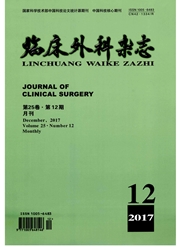

 中文摘要:
中文摘要:
目的:提高颅内孤立性纤维瘤疾病的诊治水平。方法总结2008年至2013年手术后经病理组织学证实的22例颅内孤立性纤维瘤,结合其术前MRI等影像学检查,术后免疫组化结果和肿瘤标志物,分析其预后。结果17例行肿瘤全切,5例因术中肿瘤血供丰富行肿瘤次全切除术,术后病理免疫组化肿瘤标志物CD34,VIM及BCL-2为阳性证实为孤立性纤维瘤。结论颅内孤立性纤维瘤诊断最终依据病理结果,全切除术后一般可以达到良好的预后。
 英文摘要:
英文摘要:
Objective To improve the diagnostic and therapeutic levels of intracranial solitary fibrous tumor(SFT). Methods From 2008 to 2013, the relative data of 22 patients with STF proved by postoperative pathology were retrospectively summarized. Preoperative MRI imaging, postoperative immuno- histochemistry and tumor markers were collected for the analysis of prognosis. Results Seventeen patients had total resection and the other 5 patient received subtotal resection for the rich blood supply of tumors. Postoperative pathology and immunohistochemistry demonstrated the positivity of CD34, VIM and BCL-2, which proved the diagnosis of STF. Conclusion Final diagnosis of intracranial STF should be based on the results of pathology. Satisfactory prognosis could be achieved after the treatment of total resection.
 同期刊论文项目
同期刊论文项目
 同项目期刊论文
同项目期刊论文
 期刊信息
期刊信息
